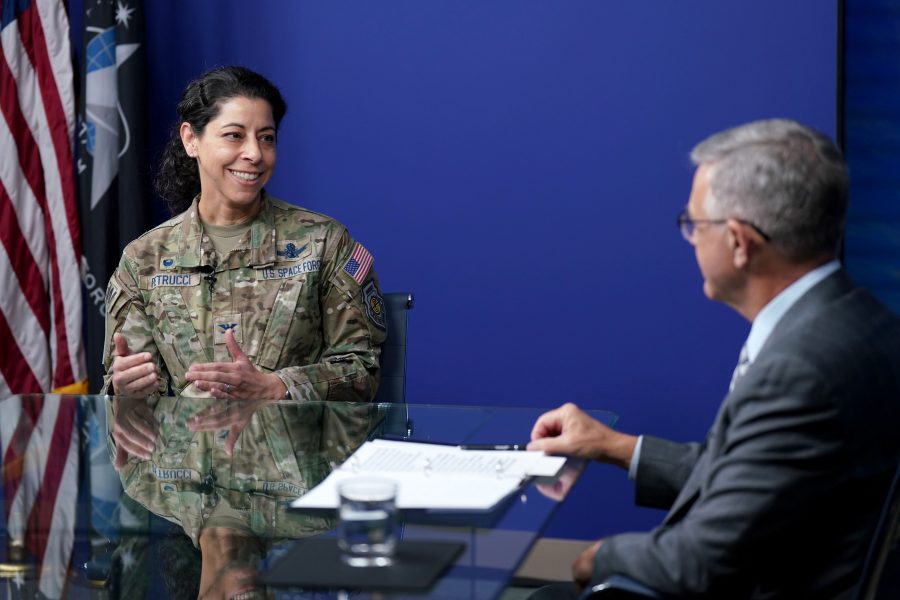
‘More EW Than We Have Ever Seen Before’ in Ukraine, Space Force Official Says (Image Credit: airandspaceforces)
The Space Force must invest in high-level training based on the lessons learned from an unprecedented level of electronic warfare (EW) used by both Russia and Ukraine in the conflict there, one of the service’s top EW leaders said on April 24.
“What we have seen in the Ukraine-Russia conflict is more EW than we have ever seen before,” Col. Nicole Petrucci, the commander of the USSF’s combat-ready forces as head of Space Delta 3, said during an AFA Warfighters in Action event. “We’ve actually been studying this very carefully to see what’s going on to see how we can help or not help—and that is unofficially, just because we’re trying to see what was the environment like.”
Ukraine and Russia have engaged in a cat-and-mouse game to jam each other’s systems. Ukraine has tried to use electronic warfare to help its air defenses confront Russian drones and missiles. Russia has interfered with signals in an attempt to disrupt global positioning system satellites that help Ukraine employ guided aerial and artillery munitions, many of which have been provided by the U.S.
The Space Force’s assessment of the Russia-Ukraine conflict may mean “we need to exercise some different tactics, some different techniques to get after what the environment looks like now,” said Petrucci, who commands roughly 600 personnel in Delta 3.
U.S. officials have acknowledged even the high level of electronic warfare in Ukraine could dwarf what the U.S. could face in a conflict with China, which would likely attempt to interfere with the satellites the U.S. military relies on for basic functions such as navigation and timing—perhaps kinetically.
China is “really looking at how has the U.S. military been able to successfully execute combat operations, what are its key enablers, and how do I as an adversary go out and break those key enablers,” a DOD intelligence official told reporters earlier this week. “The PRC has also deployed and continues to develop an expansive electronic warfare suite that is really designed to disrupt our ability to effectively use our C4ISR [command, control, communications, computers, intelligence, surveillance, and reconnaissance]. C4ISR, they’ve identified as being a key node within the U.S. way of war, that, if they are able to disrupt it, we can’t effectively execute operations in their mind.”
“They prioritize this idea of electromagnetic spectrum control,” the intelligence official added of China’s People’s Liberation Army. “Electronic warfare capabilities as well have also been deployed that are designed to target space.”
But the U.S. is not resigned to sitting idly by, Petrucci noted.
“We’re always looking to the future: ‘What does the EW look like?’” she said. “We’ve been doing it in the Space Force for four years now, but through the Air Force for at least the last 20 years in space.”
The issue is a lack of real-world experience, a primary concern of service leaders, including Chief of Space Operations Gen. B. Chance Saltzman.
“The biggest thing is getting people the right training,” Petrucci said. “You need the right simulators, you need those right ranges to do that, and you need to be able to adequately look like a high-end threat … and it means that you have to have instructors that are good enough and understand the environment.”
The need for better training is not just about spending money on a new kit, however. The service’s new force generation model, SPAFORGEN, is built upon a need to take Guardians off the front line of day-to-day work and allow them time to build up their expertise through a readiness phase devoted to training. Saltzman and other service leaders have said the threat the military imagines in the future is the primary driver of that need. The Space Force has also has Space Delta 11’s space aggressor squadrons, which Petrucci said could provide valuable insights across the service.
While space has been normalized as a warfighting domain, America still has yet to fight a war in space. Unlike the pilots in the Air Force, which has continuously provided airpower for decades, the Space Force has been built around professionals who hope never to have to use all the tools in America’s arsenal in a possible future conflagration.
“Really, what we’re looking for is how can we push this in the future?” Petrucci said. “You’re going have to have a better system. You’re going to have to have better tactics and techniques. And you need to have those operators trained well enough to be able to recognize it and then make changes while they’re in that conflict.”








